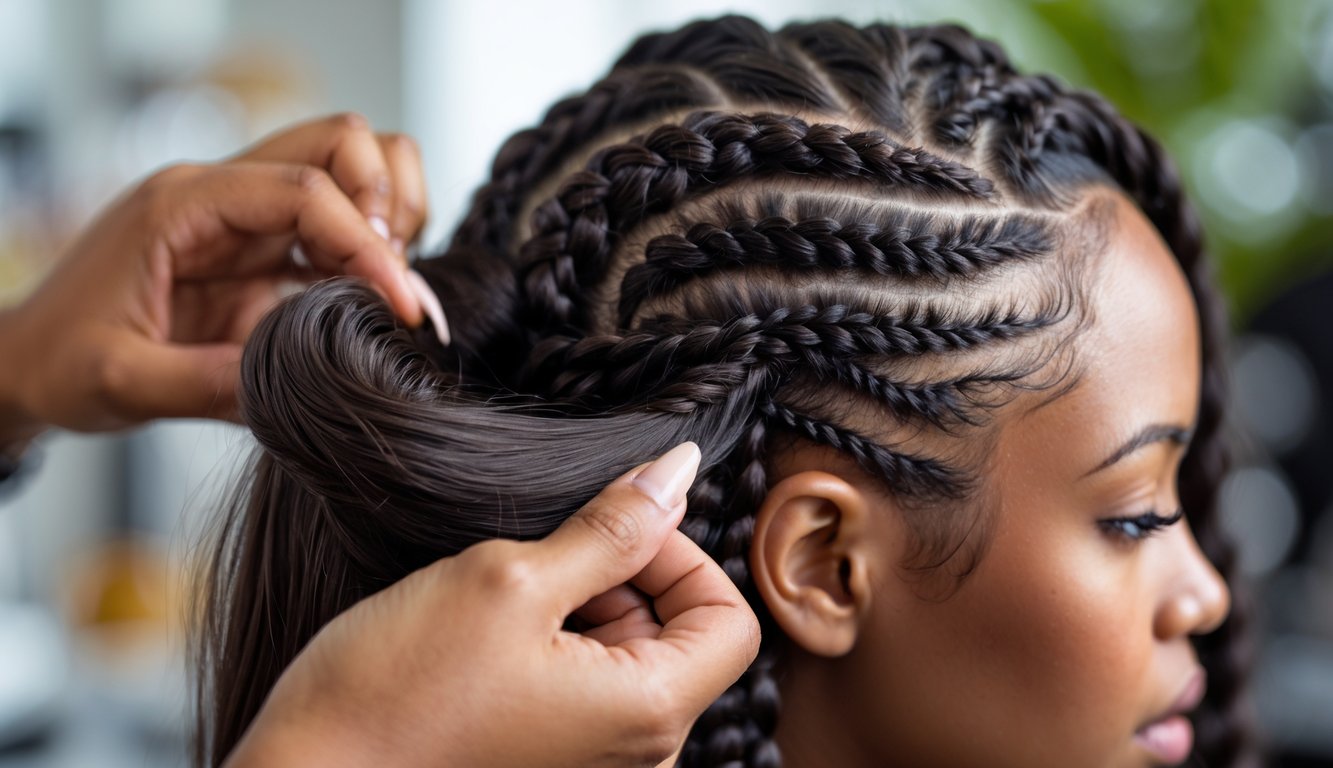
Expert Tips for Safe and Beautiful Braiding
Broken edges, flaky scalp—I’ve seen it all, and if you haven’t, you probably will. Skipping best practices or trusting random YouTube hacks isn’t clever, it’s just asking for trouble. Traction alopecia nightmares are real.
When to Visit a Professional Stylist
Appointment dread is real, but nothing ruins braids faster than ignoring warning signs: constant scalp irritation, sudden hair shedding, strands everywhere. I’ve seen so many people try to DIY from YouTube before finally giving up and calling a pro.
Red flags: sore scalp for days, red spots (that’s inflammation, by the way), uneven braids—anything that leaves your hair looking lopsided or too tight. “See a trained stylist if you notice thin spots or traction signs,” says Sam Villa ambassador Kauilani Goodwyn. Pros know how to adjust tension, sectioning, and product use—like telling you to use a lightweight leave-in instead of those anti-itch dollar store oils. They see things you don’t. Did you know 65% of people with repeat braid breakage didn’t realize it was a “medical” issue until a trichologist told them? Don’t be that person.
Best Practices for At-Home Braiders
Snapping elastics, crooked plaits, that awful feeling when a “protective” braid is just wrong—rushing always backfires. I’ve lost count of the times I tried braiding damp hair after wash day, thinking it’d “set better.” Nope: damp braids + cotton pillowcase = breakage, every time. The only thing that works is starting with dry, stretched hair—no heat if you care about your ends.
Detangle gently; don’t just rip through. Rat-tail combs make clean parts (or try a teasy brush, your edges will thank you). Tension: if your scalp looks pulled or feels sore, it’s too tight, not “neat.” Use satin scrunchies for ends, avoid rubber bands like the plague. Even stylists at Eva Scrivo Salon say, “Two to three days max for most braids if you want mermaid waves but still like your edges.” Silk scarves at night keep flakes away and save you hours detangling later. And why does no one mention lint? It’s everywhere if you don’t cover up.
Preventing Excessive Shedding and Irritation
Sudden shedding? I blamed stress until I realized it was my shampoo and braids teaming up to destroy my scalp. It’s never just the style—repeating the same braid pattern every week or using heavy oils will guarantee irritation. Synthetic hair can literally rub your skin raw (dermatitis, anyone?).
Practice matters: swap braid placements, use hypoallergenic extensions, skip harsh edge controls. Dermatologists I know swear by light, unscented scalp mists (SPF if you’re outside) and taking a month between tight styles. The real trick? Gentle detangling when taking braids out—tugging means more shedding, always. Sometimes hair just wants to rebel, but mixing things up lets follicles recover. Once saw a client with perfect cornrows but a bald nape—she forgot to moisturize her neckline for months. Unfiltered water and product buildup sneak up, so clarify quarterly unless you’re into confetti hair.
Frequently Asked Questions
Why does hair never seem to thrive with braids, even though every salon acts like it’s foolproof? I just want answers that work—like which braid patterns actually help, why breakage sneaks up, and when “tight” turns into a real problem instead of just a twinge. Is that too much to ask?
What are the healthiest hair braiding techniques to promote growth?
Box braids are everywhere—Instagram, Pinterest, random aunties at the grocery store—but honestly, my scalp always ends up yelling at me unless I’m super careful about not yanking every section tight. Why is it so hard to remember not to pull? I swear, my hair’s just happier with those regular three-strand braids that start at the root but aren’t strangling my follicles. Tension-aware partings, supposedly the “secret,” but it’s not exactly rocket science, right? And yet, here I am, always forgetting and giving myself a headache. Too tight? Hairline’s gone. Simple.
Microbraids? Absolute chaos for my fragile hair. Amber Rose (yes, that Amber Rose—she knows her stuff, apparently) told Allure to go chunky at the roots if you care about length. Still, every third YouTube hair guru swears tighter is better. Sure, Jan. Has any dermatologist ever said, “Hey, inflamed follicles equal hair growth!”? No. Literally no one.
Which protective styles should I consider for optimal scalp and hair health?
Cornrows. Ugh. Some people say they’re bad because your scalp’s all out in the open, others act like goddess braids are the holy grail. I don’t know. I just want my scalp to breathe and not turn into a flaky mess. Single plaits with clean parts—like those WebMD diagrams—usually keep things from getting matted and gross underneath.
Twists with that plastic-y kanekalon hair? Disaster. I sweat once and they’re basically dead. Human hair’s a different beast, but who can afford that every month? When I swap between flat twists and big knotless braids, my scalp chills out. Dermatologist said: bigger patterns, less tension, fewer weird bumps. Seems legit.
How can I modify my braiding routine to minimize hair breakage?
If I skip finger-detangling, it’s over. Breakage everywhere. Supposedly, slippery leave-ins (no silicones, please) are magic for getting braids in without drama, but then I grab a nylon comb and just shred my ends like a fool. I’ve seen people slather edge control all over as if it’s a detangler? No. It’s for edges, not roots. Why is this so hard to understand?
Protective sprays or a bit of lightweight oil—those actually help if I remember to use them before pulling anything tight. But if I skip the wide-tooth comb and just go at it, the only thing multiplying is my regret.
Can you recommend braiding practices that help maintain hair thickness?
No one’s asking for those sad, stringy braids on thick hair. Looks weird. Stylists keep saying: bigger sections, keep the density. Tiny parts? Thins everything out. I read that in some trichologist’s report—real “hair scientist” vibes. Also, if you keep braiding in the exact same spot every time, you’ll end up with bald patches. Not cute.
So, I started moving my parts around every time I redo my hair. Does it look a little random? Maybe. But my hair’s still thick, so whatever. My friend with the teeny-tiny feed-ins? She’s basically living in headscarves now.
What are the signs that my hair braiding might be too tight and damaging?
If I get a headache right away, that’s not “normal”—it’s my scalp screaming. My edges itch, little white bumps pop up (follicular pustules, if you want to sound fancy), and by then, it’s already too late. Dermatologists say that’s damage, not “adjusting.” If a stylist tells me “pain is beauty” and offers Tylenol? I’m out. No style is worth losing my edges.
Sometimes, random hairs escape the braids after a day and I’m like, “Is that just shedding?” Nope, that’s breakage. Still don’t get why people use spicy scalp sprays for pain—pretty sure that’s not helping anything.
How often should I rest my hair between braiding sessions for healthy growth?
Honestly, I used to just rip out old braids and slap in new ones, like, the same day. Regret. My trichologist—yeah, I have one, don’t judge—told me, “Four to six weeks in braids, then at least a week with your hair out. Two weeks if you can actually stand the shrinkage and frizz.” Meanwhile, everyone I follow online? They’re just out here jumping straight into the next install, like their scalp is made of titanium or something.
And that thing people say about “Oh, you can leave protective styles in for three months, no problem”? Apparently, that’s just… wrong. There was an actual study (Indique Hair posted a FAQ, I think?) and after six weeks, your hair’s risk of breakage basically skyrockets—like 70% higher. But does my cousin listen? Nope. She’ll rock box braids for ten weeks straight, then complain her nape looks patchy. I mean, what did she expect?



